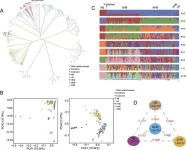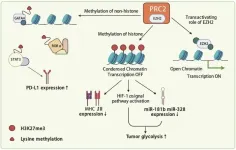(Press-News.org) UNIVERSITY PARK, Pa. — Everyone has moments of forgetfulness from time to time, especially as we get older. But older adults don’t just have difficulty remembering new information. They also have a harder time modifying those memories when new details emerge. Yet, little is known about the mechanisms behind memory updating and how those mechanisms go awry with age.
A team of researchers from Penn State has identified an enzyme that contributes to age-related impairments in memory updating. When blocked, older mice were better able to incorporate new information and performed similarly to their younger counterparts. The researchers said the findings, which published in Frontiers in Molecular Neuroscience, may lead to the development of potential therapeutic targets for improving cognitive flexibility in old age.
“It’s important to understand what’s happening at a molecular level during a memory update because, as humans, most of our memories are updates. We’re constantly building on things we already know and modifying existing memories,” said Janine Kwapis, assistant professor of biology and senior author of the paper. “But no one has really looked to see if the mechanisms behind memory formation and memory updating are identical or if they are unique for memory updating. This is a step forward in figuring that out.”
When a memory forms, the brain rewires itself to keep that memory in place through a process called consolidation. Cells express proteins at the synapse, the gap between neurons that allows communication between nerve cells, linking together the cells activated when the memory formed. When the memory is recalled, those cells then fire together at the same time.
“When you’re presented with new information, you have to bring that existing memory out of storage and weaken it so it’s ready to take on new information. Once the new information is learned and those new neurons are incorporated, the updated memory is solidified and stored again,” Kwapis said. Kwapis noted that this process, called reconsolidation, becomes less effective with age.
In this study, the research team wanted to understand why it’s harder to update memories with normal aging. If they could enhance gene expression during reconsolidation, could they enhance the memory update too?
To test this, they blocked histone deacetylase 3 (HDAC3), an enzyme that regulates gene transcription, the process of copying information from a DNA segment into RNA that will ultimately make a functional protein. HDAC3 has been shown to negatively affect memory formation and gene expression during consolidation but the researchers said its role in memory reconsolidation wasn’t previously studied.
“HDAC3 typically tightens up the chromatin, a complex of DNA and proteins, and makes it hard for transcription to happen,” said Chad Smies, a doctoral student in biology and first author of the paper. “If we block this enzymatic activity from happening, it may help maintain a more open chromatin state and improve gene expression.”
When HDAC3 was blocked during the memory reconsolidation phase, it prevented the typical age-related deficits in memory updating. Older mice performed as well as their younger counterparts during a memory update task.
The team used a methodology called the objects in updated locations paradigm, which Kwapis developed specifically to test memory updating. It includes three phases: a training session where mice learn two locations of identical objects; an update session where one of the objects is moved to a new location; and a test session where the objects are placed in four separate locations — the original two training locations, the updated location and a completely novel location.
“Mice like novelty so if they have good memory for the training session or the update session, they’ll explore the novel object location more,” Smies said. “But if they have poor memory, they tend to explore the previously learned locations equally as the new location.”
By identifying molecular mechanisms like HDAC3, the research team said they hope to provide potential therapeutic targets for improving cognitive flexibility in old age.
“If these mechanisms improve memory in normal aging, they could potentially help with conditions like Alzheimer’s disease and dementia too,” Kwapis said.
Other Penn State authors on the paper include Lauren Bellfy, doctoral student in the molecular, cellular and integrative biosciences, and Chad Brunswick, doctoral student in the neuroscience program. Destiny Wright and Sofia Bennetts, who were undergraduate students at Penn State during the time of the research; Mark Urban, a postdoctoral scholar at Penn State during the time of the research; and Guanhua Shu, who was a graduate student at Harvard University at the time of the research, also contributed to the paper.
Funding from the National Institute on Aging, Hevolution/American Federation for Aging Research and the Penn State Paul Berg Early Career Professorship funded this research.
END
Memory problems in old age linked to a key enzyme, study in mice finds
2024-08-09
ELSE PRESS RELEASES FROM THIS DATE:
National study shows how internal medicine chief residency has changed over 20 years
2024-08-09
New research shows how the chief resident position in academic internal medicine residency programs has evolved over the past 20 years, revealing how the position has changed, the types of careers these individuals pursue, and improvement in gender representation.
These findings, published this summer by the American Journal of Medicine, stem from a 20-year multicenter study that involved the University of Colorado Internal Medicine Residency Program. CU Department of Medicine faculty member William Turbyfill, MD, was among the study’s site investigators.
Turbyfill, who practices in the Veterans Affairs ...
VA’s Disrupted Care National Project discovers vascular surgery rates still decreasing since COVID-19 pandemic
2024-08-09
White River Junction, VT – Recently published findings from the VA Disrupted Care National Project (DCNP) revealed the number of vascular surgeries performed across the United States continued to decline even after large drops during the COVID-19 pandemic.
A multi-institutional team of researchers, led by the White River Junction VA Medical Center, analyzed 21,031 vascular surgeries of three common procedures from 2019 to 2023 using Medicare claim data. There was a dramatic drop of 47% at the beginning of the pandemic, but while rates of care recovered partially another ...
Looking to boost your heart health? Try a baked potato
2024-08-09
The potato is small enough to fit inside a person’s hand yet contains enough nutrients to whittle waistlines and lower blood sugar in adults with Type 2 diabetes. Yet, despite the fact that potatoes – particularly the skins – are packed with health-boosting nutrients, they routinely get a bad rap among dieters.
That may soon change, thanks to new research by Neda Akhavan, assistant professor in the Department of Kinesiology and Nutrition Sciences within UNLV’s School of Integrated Health ...
Experts provide further proof of role testosterone plays in preventing severe Covid
2024-08-09
A new study has revealed important information about how a patient’s testosterone level can help protect them from severe Covid-19.
Previous research involving Swansea University investigated how sex hormones are likely to be important determinants of Covid-19 severity.
Now digit ratio expert Professor John Manning, of the Applied Sports, Technology, Exercise and Medicine (A-STEM) research team, has been working with colleagues in Poland and Sweden to look more closely at the subject.
He says their findings, which have just been published ...
Vegan diet better than Mediterranean diet for weight loss and reducing harmful inflammatory dietary compounds, finds new research
2024-08-09
WASHINGTON, D.C.—Eating a low-fat vegan diet reduces harmful inflammatory dietary compounds called advanced glycation end-products (AGEs) by 73%, compared to no reduction on a Mediterranean diet, according to new research by the Physicians Committee for Responsible Medicine published in Frontiers in Nutrition. The decrease in AGEs on the vegan diet was associated with an average weight loss of 13 pounds, compared with no change on the Mediterranean diet.
The reduction of dietary AGEs on the low-fat vegan diet came mainly from excluding the consumption ...
'PTNM' System provides new classification for Peyronie's disease and penile curvature
2024-08-09
August 9, 2024 — Analysis of men seen at a specialist clinic provides new insights into the classification of Peyronie's disease (PD) subtypes, according to a report in the September issue of The Journal of Urology®, an Official Journal of the American Urological Association (AUA). The journal is published in the Lippincott portfolio by Wolters Kluwer.
"By analyzing real-world clinical data in a large group of patients, we identified four distinct subtypes of PD, and additional categorization of other causes of penile curvature," comments Landon Trost, MD, of Male Fertility and Peyronie's ...
The molecular shield: how tea plants combat drought through protein phosphorylation
2024-08-09
A pivotal study has discovered a protein phosphorylation mechanism that plays a critical role in the negative regulation of flavonoid biosynthesis in tea plants (Camellia sinensis) during drought stress. This insight into the molecular response of tea plants to environmental stress could lead to the development of agricultural strategies to enhance crop resilience and quality preservation under water scarcity conditions.
Drought stress poses a significant challenge to agriculture, causing substantial yield losses in many crops. Tea plants, known for their rich flavonoid content ...
Spectral measurements capable of estimating nutrient content of forest tree leaves
2024-08-09
The general health of forests can be estimated by the micro- and macronutrient content of tree leaves to help inform forest management decisions in the light of climate change, species loss and other variables. Traditional methods of assessing nutrient levels in forests are expensive and labor-intensive. Researchers recently analyzed the reflected spectra from tree foliage to accurately estimate the nutrients of leaves, offering a faster, larger-scale method of assessing forest health.
Field methods of collecting leaf samples ...
Blueprint for blueberry improvement: genetic and epigenetic discoveries
2024-08-09
Recent research has uncovered significant genetic and epigenetic variations in blueberry cultivars, particularly between northern highbush (NHB) and southern highbush (SHB) blueberries. The study highlights gene introgression's role in SHB's adaptation to subtropical climates and identifies key genes, such as VcTBL44, associated with fruit firmness. These findings offer valuable insights and resources for future blueberry breeding.
Blueberries, part of the Vaccinium genus, are renowned for their nutritional benefits and increasing global demand. However, cultivation faces challenges like ...
The heightened importance of EZH2 in cancer immunotherapy
2024-08-09
Enhancer of zeste homolog 2 (EZH2) is a catalytic subunit of the Polycomb-repressive complex 2 (PRC2), which plays a crucial role in transcriptional repression through the methylation of histone H3 on lysine 27 (H3K27me3). This epigenetic modification leads to chromatin compaction and gene silencing. EZH2 is frequently overexpressed in a variety of cancers, including head and neck, breast, prostate, bladder, colorectal, lung, pancreatic, melanoma, and lymphoma. Mutations in the EZH2 gene are also prevalent in several hematological malignancies, such as B-lymphomas and follicular lymphomas. The dual role of EZH2 as both a tumor suppressor and oncogene depending on the cancer type ...



